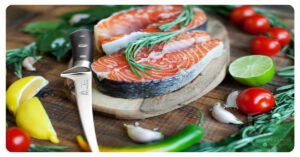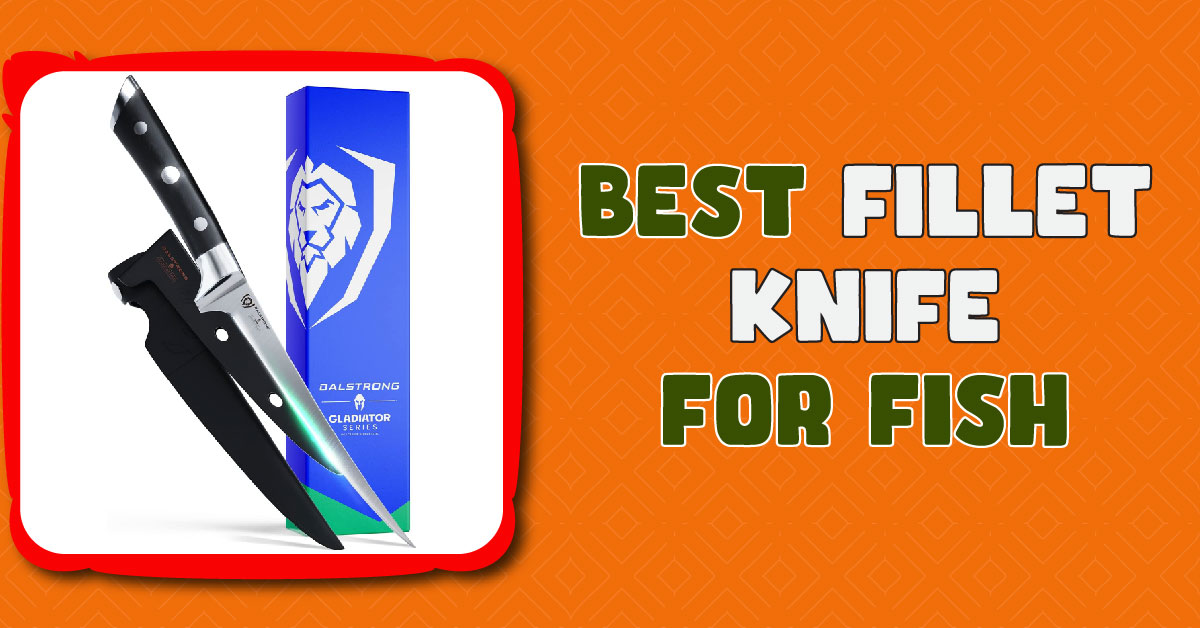A sharp fillet knife makes all the difference. I’ve used knives that slice clean and others that turn fish into a struggle. If you’re wondering what a fish knife is or if an electric fishing fillet knife is worth it, I’ve got you covered. This guide will help you pick the best fillet knife for fish, whether you need one for freshwater or saltwater. I’ll also share top-rated options and expert tips.
What is a Fish Knife?
A fish knife is a special tool made for cleaning and filleting fish. It is thinner and more flexible than a regular kitchen knife. This helps it glide through the flesh without tearing. If you’ve ever used a dull or stiff knife, you know how frustrating it can be. A good fish knife makes the job easy and smooth.
A fillet knife is a fish knife made for removing skin and bones. It is different from a chef’s knife, which is thicker and less flexible. A fillet knife bends just enough to follow the shape of the fish. This helps you get the most meat with little waste.
The best fish knives are sharp, flexible, and comfortable to hold. Stainless steel blades resist rust, while high-carbon steel stays sharp longer. A good handle gives you a firm grip, even when wet. Whether you’re working with a small trout or a big tuna, the right knife makes all the difference.
Types of Fish Fillet Knives
Not all fillet knives are the same. Some are made for careful cuts, while others focus on speed and power. The right knife depends on the fish and how often you fillet. Let’s go over the main types.
Manual Fillet Knives
A manual fillet knife is the best choice for control. It lets you make clean, smooth cuts. The blade is thin and bends slightly, helping you remove meat from bones. If you fillet small fish like trout or bass, a 6- to 7-inch blade is great. For bigger fish, go for an 8- to 10-inch blade.
Electric Fishing Fillet Knives
An electric fishing fillet knife makes the job fast and easy. It slices through thick skin and bones with little effort. This is great for large fish like catfish or redfish. But keep in mind that electric knives don’t give the same careful cuts as manual ones.
Japanese Fish Knives
A Japanese fish knife, like a Deba or Yanagiba, is built for sharpness and long use. These knives have one sharp side and one flat side. This helps make thin, precise cuts. Sushi chefs love them. They take practice to use, but they give perfect slices.
Best Saltwater Fish Fillet Knife
Saltwater fish have thick skin and strong bones. A saltwater fillet knife needs to be tough and resist rust. High-carbon stainless steel is a great choice because it stays sharp. A non-slip handle helps you keep control, even when wet. If you fillet snapper or tuna, this type of knife will make things easier.
Best Rated Fish Fillet Knives
Finding the right fillet knife can be tricky. Some knives feel natural in your hand, making filleting smooth and easy. Others just make the job harder. After testing and research, I’ve found the top-rated fillet knives. These are based on real reviews and expert opinions.
1. Bubba 9-Inch Tapered Flex Fillet Knife
This knife is sharp, flexible, and built to last. The non-slip grip keeps your hand steady, even when wet. It glides through fish with ease, making it great for both small and big catches.
✅ Best for: Freshwater and saltwater fish
✅ Blade Material: High-carbon stainless steel
✅ Why It’s Great: Strong, sharp, and easy to hold
2. Rapala Fish’n Fillet Knife
This classic knife is a favourite among anglers. The thin, flexible blade makes clean cuts simple. It also comes with a leather sheath and sharpening tool, so you’re always ready to fillet.
✅ Best for: Beginners and casual anglers
✅ Blade Material: Stainless steel
✅ Why It’s Great: Lightweight, easy to use, and budget-friendly
3. Wüsthof Classic 7-Inch Fillet Knife
If you love precision and quality, this German-made knife is a solid choice. It’s razor-sharp and well-balanced, making filleting smooth and effortless.
✅ Best for: Professional chefs and serious anglers
✅ Blade Material: High-carbon stainless steel
✅ Why It’s Great: Super sharp and built to last
4. Dexter-Russell 8-Inch Fillet Knife
Dexter-Russell is known for high-quality knives, and this one is no different. The grippy handle and flexible blade make it a great pick for both home and pro use.
✅ Best for: Large fish like salmon and tuna
✅ Blade Material: High-carbon steel
✅ Why It’s Great: Affordable, flexible, and easy to sharpen
5. Bubba Li-Ion Electric Fillet Knife
Need to fillet a lot of fish fast? This electric knife has a strong motor and comes with four different blades. It’s perfect for big jobs and thick-skinned fish.
✅ Best for: High-volume filleting
✅ Blade Material: Stainless steel
✅ Why It’s Great: Cuts through fish fast with little effort
How to Choose the Best Fillet Knife for Fish
Picking the right fillet knife is like choosing the perfect fishing rod it makes everything easier. A dull, stiff knife can ruin a good catch, while the right one glides through fish like butter. But with so many options, how do you find the best one? Let’s break it down.

A fillet knife needs to stay sharp and resist rust. Stainless steel blades don’t rust easily, making them perfect for saltwater fishing. But they dull faster. High-carbon steel holds a sharp edge longer but needs extra care to prevent rust. If you fish often, a high-carbon blade is worth it. Otherwise, stainless steel is a safe bet.
✅ Tip: If you fish in saltwater, go for stainless steel. If sharpness is your top priority, choose high-carbon steel.
2. Blade Length: What’s the Right Size?
The right blade length depends on the fish you’re filleting. Smaller fish like trout or crappie need a 6- to 7-inch blade. Medium-sized fish like bass or walleye work well with an 8-inch blade. For larger fish like salmon or tuna, go for a 9- to 10-inch blade.
✅ Tip: Match the blade size to the fish. Small fish? Short blade. Big fish? Long blade.
3. Flexibility: Stiff vs. Flexible Blades
A good fillet knife should bend slightly as it moves along the bones. More flexibility means cleaner cuts with less waste. For delicate fish like panfish or trout, a highly flexible blade is best. For larger, tougher fish, a stiffer blade works better.
✅ Tip: Flexible blades = precise cuts for soft fish. Stiff blades = power for thick-skinned fish.
4. Handle Grip & Comfort: Don’t Overlook This!
A slippery handle is a disaster waiting to happen. A good fillet knife should feel comfortable and secure, even when wet. Rubberized grips offer the best control, while wood handles look nice but can get slippery. Textured plastic handles are also a solid choice.
✅ Tip: If you fillet often, get a rubber or textured handle for a firm grip.
5. Manual vs. Electric: Which One Should You Get?
A manual fillet knife gives you total control, making it ideal for precise, detailed cuts. But if you need to process a lot of fish fast, an electric fillet knife will save you time. Just know that electric knives can be too aggressive for delicate fish.
✅ Tip: Manual for precision, electric for speed. Choose based on how often and how much you fillet.
Proper Maintenance & Sharpening Tips
A good fillet knife is like a fishing buddy—treat it well, and it’ll never let you down. But even the best knife won’t stay sharp forever. If you’ve ever tried to fillet a fish with a dull blade, you know how bad it gets. Instead of clean, smooth cuts, you end up tearing the meat. It’s frustrating. Let’s make sure that never happens.
Keep Your Knife Sharp: The Secret to Easy Filleting
A sharp knife isn’t just better—it’s safer. A dull blade forces you to push harder, making slips more likely. The best way to keep your knife razor-sharp? Regular sharpening.
✅ Use a whetstone: A Japanese whetstone gives you a sharp, polished edge. Soak it in water for 10 minutes, then glide the blade over it at a 15-degree angle. A few strokes on each side will do the trick.
✅ Try an electric sharpener: Short on time? An electric sharpener works fast. Just make sure it’s made for fillet knives. Some sharpeners are too rough and can wear down the blade.
✅ Honing steel for touch-ups: This won’t fix a dull knife, but it keeps the edge aligned. A few swipes before each use can help.
Clean Your Fillet Knife: Stop Rust Before It Starts
A good fillet knife is an investment. The last thing you want is rust eating away at your blade. Fish knives, especially high-carbon steel ones, need the right care to last.
✅ Wash it right away: Don’t let fish guts and saltwater sit on the blade. Rinse it under warm water with mild soap. Dry it completely before storing.
✅ Oil the blade: A thin coat of mineral oil prevents rust. This is a must if you use your knife in saltwater.
✅ Store it properly: Tossing your knife in a drawer is a bad idea. It can dull or damage the blade. Use a sheath, magnetic strip, or knife block instead.
If you fillet saltwater fish, rinse your knife in fresh water before drying. Salt speeds up rust.
What I Like
A great fillet knife makes fish cleaning easier, and this brand delivers. After using many knives, I’ve found some standout features that make this one a favorite.
- Super Sharp Blade – Right out of the box, the blade is razor-sharp. It slices through fish like butter, making filleting fast and effortless.
- Perfect Flexibility – The blade bends just enough to follow the fish’s shape, helping me get the most meat with little waste.
- Comfortable Handle – The grip feels secure, even when wet. No slipping, no discomfort—just a solid hold for smooth cutting.
- Rust-Resistant Material – Whether I’m fishing in saltwater or freshwater, I don’t have to worry about rust. The stainless steel blade stays in top shape.
- Durable & Long-Lasting – I’ve used this knife for a long time, and it still holds up. With proper care, it stays sharp and reliable.
What Could Be Better
While this knife is great, no product is perfect. Here are a few things that could be improved, but nothing that would stop me from recommending it.
- Needs Regular Sharpening – Like all high-quality knives, it needs sharpening over time. A quick touch-up keeps it performing at its best.
- Not Ideal for All Fish Sizes – While it works well for most fish, very large species might need a longer blade. Choosing the right size solves this.
- Electric Option Would Be Nice – A powered version for high-volume filleting would be useful. But for precision cuts, this manual knife is still my top pick.
My Personal Experience
I’ve been using this brand’s fillet knives for years, and they’ve never let me down. From freshwater trout to saltwater snapper, these knives make filleting smooth and effortless. Here’s why they stand out.
Design
A well-designed knife makes a difference, and this one feels like it was made for serious fishers. The ergonomic handle fits comfortably in my hand, even during long filleting sessions. The blade has the perfect curve for clean, precise cuts.
Performance
This knife doesn’t just cut—it glides. The sharp edge makes filleting quick and easy, reducing waste and giving me perfect fillets every time. Whether I’m slicing through delicate fish or tougher species, it handles the job without struggle.
Build Quality
Durability matters, and this knife delivers. The stainless steel resists rust, and the edge holds up even after many uses. With proper care, it stays sharp and strong for years, making it a great investment for any angler.
Conclusion
A good fillet knife changes everything. If you’ve ever fought with a dull blade, you know how frustrating it is. The right knife makes filleting smooth, easy, and even fun.
So, what’s the best fillet knife for fish? It depends on what you need. A manual fillet knife gives control and precision. An electric fishing fillet knife saves time on big catches. Japanese fish knives offer unmatched sharpness. And for saltwater fish, a rust-resistant, heavy-duty knife is a must.
No matter which one you choose, keeping it sharp and well-maintained is key. A dull knife slows you down, wastes good meat, and makes filleting harder than it should be. A few minutes of care can make your knife last for years.
FAQs
What is the best fillet knife for fish?
The best fillet knife depends on your needs. Manual knives offer control, while electric knives work fast. Japanese knives provide extreme sharpness.
What size fillet knife is best for different fish?
For small fish like trout, a 6-inch blade is great. Medium-sized fish like bass need 7-8 inches. Large fish like salmon or tuna need a 9-10 inch blade.
Are electric fillet knives worth it?
Yes, if you clean lots of fish. They save time and effort, especially for thick-skinned or large fish. But manual knives give more precision.
How do I keep my fillet knife from rusting?
Wash and dry it right after use. Apply a thin layer of oil, especially for high-carbon steel. Store it in a sheath or dry place.
What’s the best saltwater fish fillet knife?
A rust-resistant stainless steel knife with a non-slip handle works best. Look for brands that make knives for marine use.

